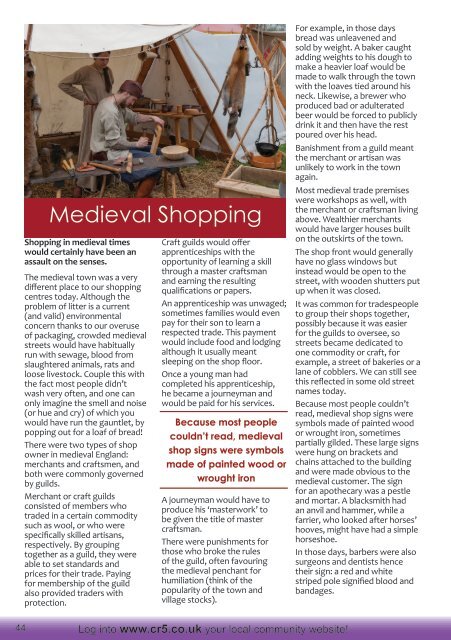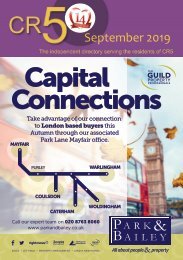CR5 Issue 171 August 2019
A local independent community magazine delivered free to 11,800 homes every month in the CR5 postcode. Contains local business advertising, interesting reads, Competitions, What's on in the Community and Puzzles.
A local independent community magazine delivered free to 11,800 homes every month in the CR5 postcode.
Contains local business advertising, interesting reads, Competitions, What's on in the Community and Puzzles.
Create successful ePaper yourself
Turn your PDF publications into a flip-book with our unique Google optimized e-Paper software.
Medieval Shopping<br />
Shopping in medieval times<br />
would certainly have been an<br />
assault on the senses.<br />
The medieval town was a very<br />
different place to our shopping<br />
centres today. Although the<br />
problem of litter is a current<br />
(and valid) environmental<br />
concern thanks to our overuse<br />
of packaging, crowded medieval<br />
streets would have habitually<br />
run with sewage, blood from<br />
slaughtered animals, rats and<br />
loose livestock. Couple this with<br />
the fact most people didn’t<br />
wash very often, and one can<br />
only imagine the smell and noise<br />
(or hue and cry) of which you<br />
would have run the gauntlet, by<br />
popping out for a loaf of bread!<br />
There were two types of shop<br />
owner in medieval England:<br />
merchants and craftsmen, and<br />
both were commonly governed<br />
by guilds.<br />
Merchant or craft guilds<br />
consisted of members who<br />
traded in a certain commodity<br />
such as wool, or who were<br />
specifically skilled artisans,<br />
respectively. By grouping<br />
together as a guild, they were<br />
able to set standards and<br />
prices for their trade. Paying<br />
for membership of the guild<br />
also provided traders with<br />
protection.<br />
Craft guilds would offer<br />
apprenticeships with the<br />
opportunity of learning a skill<br />
through a master craftsman<br />
and earning the resulting<br />
qualifications or papers.<br />
An apprenticeship was unwaged;<br />
sometimes families would even<br />
pay for their son to learn a<br />
respected trade. This payment<br />
would include food and lodging<br />
although it usually meant<br />
sleeping on the shop floor.<br />
Once a young man had<br />
completed his apprenticeship,<br />
he became a journeyman and<br />
would be paid for his services.<br />
Because most people<br />
couldn’t read, medieval<br />
shop signs were symbols<br />
made of painted wood or<br />
wrought iron<br />
A journeyman would have to<br />
produce his ‘masterwork’ to<br />
be given the title of master<br />
craftsman.<br />
There were punishments for<br />
those who broke the rules<br />
of the guild, often favouring<br />
the medieval penchant for<br />
humiliation (think of the<br />
popularity of the town and<br />
village stocks).<br />
For example, in those days<br />
bread was unleavened and<br />
sold by weight. A baker caught<br />
adding weights to his dough to<br />
make a heavier loaf would be<br />
made to walk through the town<br />
with the loaves tied around his<br />
neck. Likewise, a brewer who<br />
produced bad or adulterated<br />
beer would be forced to publicly<br />
drink it and then have the rest<br />
poured over his head.<br />
Banishment from a guild meant<br />
the merchant or artisan was<br />
unlikely to work in the town<br />
again.<br />
Most medieval trade premises<br />
were workshops as well, with<br />
the merchant or craftsman living<br />
above. Wealthier merchants<br />
would have larger houses built<br />
on the outskirts of the town.<br />
The shop front would generally<br />
have no glass windows but<br />
instead would be open to the<br />
street, with wooden shutters put<br />
up when it was closed.<br />
It was common for tradespeople<br />
to group their shops together,<br />
possibly because it was easier<br />
for the guilds to oversee, so<br />
streets became dedicated to<br />
one commodity or craft, for<br />
example, a street of bakeries or a<br />
lane of cobblers. We can still see<br />
this reflected in some old street<br />
names today.<br />
Because most people couldn’t<br />
read, medieval shop signs were<br />
symbols made of painted wood<br />
or wrought iron, sometimes<br />
partially gilded. These large signs<br />
were hung on brackets and<br />
chains attached to the building<br />
and were made obvious to the<br />
medieval customer. The sign<br />
for an apothecary was a pestle<br />
and mortar. A blacksmith had<br />
an anvil and hammer, while a<br />
farrier, who looked after horses’<br />
hooves, might have had a simple<br />
horseshoe.<br />
In those days, barbers were also<br />
surgeons and dentists hence<br />
their sign: a red and white<br />
striped pole signified blood and<br />
bandages.<br />
44 Log into www.cr5.co.uk your local community website!
















